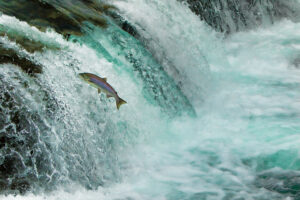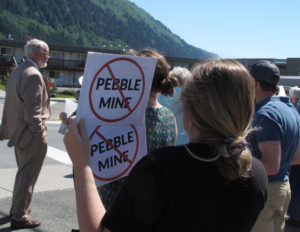How Oil Industry Lobbyists Played the Long Game to Access a Fuel-Rich Corner of Alaskan Wilderness
The story of how the oil company ConocoPhillips overcame years of resistance from courts, native Alaskans, environmental groups and several federal agencies reveals the truth about how Washington really works. Joseph Sohm / Shutterstock
1
2
3
Joseph Sohm / Shutterstock
1
2
3
Back in Washington, Lundquist was a regular on the political fundraiser circuit. Over the course of his lobbying career, according to the Center for Responsive Politics, he would give more than $165,000 in contributions — 93 percent of it to Republicans. Companies expected lobbyists to devote a sizable portion of their fees to contributions to candidates that the companies needed on their side.
Lundquist’s business was growing fast. At first, he shared his office suite — decorated with portraits of Native Alaskans — with Joe Allbaugh, a jocular Oklahoman who had made his name as George W. Bush’s Federal Emergency Management Agency director during 9/11. As that partnership ebbed, Lundquist brought on George Nethercutt, a Washington state Republican who’d lost a bid for the Senate after a decade in the House, and Steven Griles, who recently served as deputy secretary at Interior after years as a lobbyist for coal, oil and gas companies.
In its first year the firm of Lundquist, Nethercutt & Griles reported collecting $1.3 million in lobbying fees, and the next year, $1.6 million. “We had tremendous skills and knowledge and great experience,” recalled Griles. “If you have those things you can succeed in Washington. If you’re honest and represent people fairly, you can succeed.”
The good times lasted only so long for Griles. He resigned from the firm in 2007, a few months before pleading guilty to obstruction of justice in connection with the Jack Abramoff lobbying scandal, charges that stemmed from his time at Interior. Griles was sentenced to 10 months in prison.
Nethercutt said it was an “uncomfortable” time for him and Lundquist. “We said, ‘This can’t stand — you’re going to have to leave.’ It was our reputations, too.”
Yet rather than tainting the firm, the disruption enabled Lundquist to reinvent it, this time as a bipartisan shop. Democrats had recaptured Congress in 2006, and Republican-leaning firms could be at a disadvantage. Lundquist brought on some Democrats and adopted a new name: BlueWater Strategies, suggested by one new hire, Eric Washburn, one-time energy staffer to then-Senate Democratic Leader Tom Daschle. An avid sailor, Washburn wanted to evoke “blue water navigation,” what you have to do when you’re far out in the ocean with no landmarks. “The idea is we’d help people navigate rough seas,” Washburn said.
Seas were in fact getting rougher for many in the fossil fuel industry. Within a year, Barack Obama would move into the White House after pledging to take on climate change — this, he said, could be “the moment when the rise of the oceans began to slow.”
And among the companies that turned to Andrew Lundquist for help was ConocoPhillips.
Every President Since Reagan
With more than 1.2 million acres of leases on the North Slope and a 25 percent stake in the Alaska pipeline, ConocoPhillips was on its way to becoming the largest oil producer in the state. Still, some of its ambition had been frustrated.
The Bush-Cheney years, at first, had promised to be a boon for the company, whose PAC and employees had spent more than $750,000 on the 2000 election, more than 90 percent of it for Republicans. Gale Norton, Babbitt’s successor as Interior secretary, visited the Alaskan Arctic and pronounced it a “flat, white nothingness” ripe for more extraction. In 2003, the administration announced a plan that followed the recommendations of Cheney’s task force: it would more than triple the amount of drilling in the reserve’s northeast over what Babbitt had laid out.
Crucially, under this plan, protections would be lifted on much of the area around Teshekpuk Lake. This could be done, the Bush administration vowed, without serious environmental damage, by using directional drilling and other new technologies. “We felt that a lot more could be leased,” said Henri Bisson, then Alaska director of the Bureau of Land Management, the Interior Department agency that oversees government-owned land.
Environmental groups were aghast. Even Tony Knowles, the former governor who had urged expanding drilling in NPR-A, viewed the plan as excessive. The Cheney task force “was the big change,” said Stan Senner, then the director of Audubon Alaska. “They were now willing to go into an area that every president going back to Reagan had reason to close.”
The National Audubon Society and other conservation groups filed a lawsuit, charging that the administration had failed to consider the reserve’s “international importance to migratory birds and other wildlife.” And a federal judge in Anchorage, James K. Singleton Jr., ultimately agreed, blocking the expansion.
The ruling threw NPR-A into limbo for the remainder of Bush’s second term. The drilling debate shifted to the Lower 48, where the fracking revolution was getting underway, helped by a provision in the comprehensive energy law that finally passed in 2005 exempting fracking chemicals from the Safe Drinking Water Act. It was the very provision the Cheney task force had called for in 2001.
In 2009, the Democrats were back in the driver’s seat in Washington and they were threatening to roll back the Bush rules on Alaska. To preserve its plans, ConocoPhillips had to make a new play. The oil company retained Lundquist’s BlueWater Strategies at a rate of $200,000 per year. “For Conoco, they do so much work in Alaska, that having Andrew in particular who had those really strong Alaska connections, it strengthened and reinforced what they were already looking for and seeking help on,” said Washburn, the former BlueWater partner.
Lundquist arrived on the scene too late to keep Obama’s first Interior secretary, former Colorado Sen. Ken Salazar, from producing an NPR-A plan that, on the whole, cheered environmentalists. It set aside half of the reserve for conservation and — once again — strengthened protections around Teshekpuk Lake. As Babbitt had years earlier, it also called for a buffer along Fish Creek, near Nuiqsut.
But that was just the blueprint. The real battle would come in applications for drilling. Dealing with the five federal entities that had to pass judgment on a project would be an enormous paperwork headache, but also an opportunity. You could play one group against the other as you navigated the system.
And for this, ConocoPhillips would have Lundquist’s help full time: At the start of 2013, he became the company’s senior vice president for government affairs, with a 20-person team under his command.
He left BlueWater’s office near Union Station and moved west into ConocoPhillips’s Washington office, in the heart of the K Street corridor. He gave up the boards of the mining and oil companies he’d served on, which between them had compensated him with more than $1.75 million in stock and fees over the previous seven years. And a few months later, the company filed its application to drill in NPR-A at Greater Mooses Tooth.
‘Got to Love That Name’
The name was a marketing gimmick, Alaska-style.
Moose’s Tooth, a legendary peak in Denali National Park, is 500 miles from the infinite flatness of the NPR-A’s tundra. It was also the name of a highly popular Anchorage brewpub started by some rock climbers. In short, the peak had no connection with the drill site, but it bestowed a friendly backcountry connotation.
“Got to love that name, Greater Moose’s Tooth. Only in Alaska,” Larry Archibald, ConocoPhillips’s senior vice president for exploration, had told oil-market analysts in a 2009 conference call.
With Greater Mooses Tooth (the apostrophe eventually would be dropped), ConocoPhillips was proposing the first drilling on public land in NPR-A. It was getting oil from another spot just within NPR-A boundaries, but that was on land controlled by one of the native corporations created under the Alaska Native Claims Settlement Act, not by the federal government.
The exploratory wells had been promising, Archibald told the analysts. NPR-A “keeps giving and giving nice light oil,” he said. The site was on land included in Babbitt’s 1999 lease sale, rights that ConocoPhillips had acquired from Arco. ConocoPhillips had gotten approval from the Bush-Cheney administration for a similar drilling project in 2004, when environmentalists were focused on the larger fight over Teshekpuk Lake. Now, financial conditions were finally right to proceed with production, thanks in part to a change in Alaska tax law the oil industry had secured. Because so much time had passed, the company would need to reapply.
ConocoPhillips would need approval from the Interior Department, which would rely mainly on its Bureau of Land Management (BLM), and from the Army Corps of Engineers. The U.S. Fish and Wildlife Service and the Environmental Protection Agency also would weigh in.
The stakes were high. Greater Mooses Tooth-1 would cost $890 million and add 30,000 barrels to the 200,000 barrels ConocoPhillips was producing daily in Alaska, which in 2013 had provided the company with $2.3 billion in earnings, more than a quarter of its total. More than that, it was the test of whether the Obama administration’s limits would hold, of what precedent would be set for the expanse waiting to the west.
“The GMT-1 proposal is politically sensitive at a national level,” wrote Bud Cribley, the BLM’s Alaska director, to his top staff in a memo preparing them for a teleconference with the director of the bureau, Neil Kornze, in March 2014.
And at the center of the showdown were the roads. ConocoPhillips had abandoned the roadlessapproach pioneered by its predecessor Arco — accessing sites via helicopters and ice roads, which meant restricting drilling mostly to winter. The lack of roads “destroys the economics” of the project, the company insisted. In a written response to questions for this story, a company spokesman disputed that its new approach represented a departure from the initial vision for the area. “All of the roads that have been built … were determined to be the environmentally preferred alternative,” he said.
To reach its existing site on the native corporation land within NPR-A ConocoPhillips was already building a six-mile road and a 1,400-foot bridge. This had provoked major opposition from conservation groups and the village of Nuiqsut and had, initially, been rejected by the Army Corps of Engineers. But, under pressure from the company and Alaska politicians, the Corps had reversed itself. Now, the company was proposing another road — this one 7.7 miles long, with two bridges, plus another water crossing via a culvert.
For a permanent road to function in the North Slope’s permafrost, the gravel fill needed to be piled up — between 5 and 8 feet high. This alteration of the landscape had consequences, said Sam Kunaknana, the tribal president for Nuiqsut. Caribou changed migration patterns to go around the barriers, complicating the hunting routines of villagers, who themselves found it hard to get over the roads on their snow-machines.
“We have to go further out to hunt our subsistence food, because the animals that once thrived in our area are now going further and further out,” Kunaknana said. The villagers had already given the first road a nickname: the “China wall.”
‘Nothing Short of Fraudulent’
When Babbitt returned to the North Slope in July 2013, and flew over the oil fields just outside NPR-A that Arco had developed without permanent roads, he was overwhelmed.
“You talk about things, you read about them, you get all the facts and the data and all of a sudden you see it, and it’s a revelation,” he said. “It’s a brilliant summer day, the fog disappears and the sun is shining across a vast sparkling expanse. There’s almost nothing there, except a few lines in the tundra where they’ve emplaced pipelines and a few tiny remote pumping stations — it’s otherwise undisturbed as far as the wildlife are concerned.” It confirmed his earlier judgment: this was how it should be done.
Within days of Babbitt’s trip, ConocoPhillips filed its Greater Mooses Tooth application — including a permanent road. With the landscape fresh in his mind, Babbitt decided to make NPR-A his cause, even though he was now into his 70s, and was spending much of his time in Peru monitoring roadless oil and gas projects in the Amazon. He visited BLM’s Kornze at his Washington office. He called Kornze’s boss, Sally Jewell, the former REI Inc. executive who had replaced Salazar at Interior. He wrote to ConocoPhillips’s Alaska division chief, and got a noncommittal response.
In its preliminary evaluation of the Greater Mooses Tooth project in February 2014, BLM did examine the possibility of a roadless option, but on terms that seemed designed to make it look unappealing to villagers grown leery of excessive air traffic. It envisioned year-round drilling rather than the seasonal approach used at the original Arco site. It accepted the company’s projections for frequent flights to the site. And it accepted its claim that roadless development would require a 5,000-foot airstrip to accommodate a plane that could deliver a relief-well drill rig in the event of a blowout.
This draft assessment was, Babbitt said, “nothing short of fraudulent.” At a speech in Colorado a month after it came out, he said, “BLM in Alaska is coming perilously close to acting as a leasing agent of the ConocoPhillips company.”
The roadless idea was now all but a lost cause. So Babbitt and other conservationists shifted their efforts to getting a road with the least possible impact.
The company wanted to build the shortest, cheapest route possible, even though that would cut into the three-mile setback that both Babbitt and Salazar’s plans had called for along Fish Creek, a crucial watershed and locus of subsistence hunting and fishing. In this preference — “Alternative A” — ConocoPhillips had the backing of Alaska’s elected leaders in Juneau and Washington, who were desperate to get new oil flowing in the pipeline, and of two Native Alaskan corporations, which would benefit financially.
Conservation groups wanted the road to take a slightly longer, 8.5-mile route, with only one bridge, that would steer clear of the Fish Creek setback — “Alternative B.” They had the backing of the tribal council of Nuiqsut, the group led by Kunaknana charged with safeguarding local heritage.
Building the Alternative B route, the company said, would cost nearly $50 million more and throw the project into question.
The choice would be made by the federal bureaucracy. But, to judge from e-mails obtained through public records requests, there was little doubt which side was driving the process.
Again and again, ConocoPhillips’s representative in Alaska, a blunt engineer named Lynn DeGeorge, demanded meetings with the agencies that had a say. She resisted the agencies’ request to project costs for all the options, not just the one the company preferred. She ordered them not to share designs the company was submitting, and warned them not to meet without her. She asked for early looks at BLM’s assessments. She demanded to know if BLM received public records requests. She told BLM’s project manager, Bridget Psarianos, that her inability to offer a firm approval schedule was “pitiful.”
Her assertiveness was backed up by ConocoPhillips’s considerable resources — it had committed $1.7 billion to capital projects in Alaska in 2014, double the amount from two years earlier, partly to cover the Greater Mooses Tooth expansion. The company had been flush enough to give its retiring CEO, James Mulva, the biggest exit package of any U.S. executive in 2012 — $156 million. Andrew Lundquist received stock options valued at more than $7 million in his three years on staff, on top of his base salary.
The government’s representatives, by contrast, were at frequent disadvantage. In late 2013, they had to go on furlough as a result of the government shutdown forced by congressional Republicans. A few months later, BLM’s Psarianos had trouble finding a working computer from which to send out the bureau’s latest assessment. A few months after that, she had to ask DeGeorge for GIS mapping data.
Amidst all the talk about the growth of the federal government, Interior was one of several federal departments that had seen its number of full-time employees decrease between 2004 and 2012, as more and more federal spending flowed to private contractors and expanding departments like Homeland Security. Over that time Interior’s employees had some of the smallest growth in compensation in government, average increases in salary and benefits of less than one percent per year. Within Interior, BLM’s budget has barely budged in recent decades even as its duties have expanded. This is deplored even by one of George W. Bush’s three BLM directors, James Caswell. “BLM has always been and continues to be understaffed and underfunded,” he said.
Things were hardly any better at the Army Corps. Lacking resources, the Corps had to rely on ConocoPhillips for wetlands analysis, the data that would lie at the heart of the Corps’ determination. In a June 2014 e-mail, the Corps’ project manager, Hank Baij, thanked DeGeorge for “all your work” on the analysis — as though ConocoPhillips were doing the Corps a favor by being allowed to provide the crucial data. A month later, budget constraints even forced the Corps to close its field office in Anchorage.
Despite the mismatch, by the summer of 2014, it appeared that the environmentalists and tribal council might just prevail with Alternative B. Not only BLM, but also EPA and Fish and Wildlife, were leaning toward the route outside the Fish Creek setback, judging it less damaging to the creek fishery, to the watershed and to subsistence hunting, and less risky in the event of a pipeline rupture because it involved fewer river crossings.
But Alternative A was far from dead. Back in Washington, another process was unfolding.
‘Pulling Out All the Stops’
On Sept. 17, as the Mooses Tooth decision was coming to a head, Andrew Lundquist arranged a meeting for himself and Ryan Lance, the company’s new CEO, with Deputy Interior Secretary Michael Connor. Prior to the Washington meeting, Interior and BLM staffers scrambled to prepare Connor. In their briefing paper they noted: “In recent meetings in Alaska, CP argued strenuously for Alternative A as its preferred alternative.”
A few weeks later, in late October, the BLM staff in Alaska issued its final recommendation. Alternative B, with the road outside of the Fish Creek setback, was the best option. But the final word would come from Washington, in a so-called Record of Decision issued jointly by BLM and the leadership of the Interior Department.
Interior, though, was taking its time — far longer than the usual month for a final decision, which BLM staff in Alaska attributed to the pressure from Lundquist’s team in Washington. The delay proved a blessing for the company. By slow-walking its decision, Interior gave the company an opening to persuade the Army Corps. At first blush, that seemed to be a challenge for ConocoPhillips. According to BLM employees in Alaska, representatives of the Corps had given the impression in weekly progress meetings in Anchorage with BLM that if BLM’s staff favored Alternative B, the Corps would sign on too, to avoid conflicting rulings.
But now the company put on the pressure. On Nov. 11, DeGeorge sent a lengthy letter to the Corps, suggesting a rationale for the agency to back Alternative A. “Fish Creek and the adjacent areas are important habitat for subsistence activities. However, exceptions to BLM’s Fish Creek setback are permissible,” she wrote.
A month after that, Nicholas Olds, ConocoPhillips’s vice president for North Slope operations, sent a letter to Cribley, the BLM director in Alaska. Olds hinted that the Corps was now leaning toward the company’s position. He put BLM on notice that it should be prepared to reverse its recommendation or risk having a split decision by the government that would stall the whole project.
Baij, the Corps project manager, began telling his counterparts at BLM that after contacts with company representatives he feared ConocoPhillips would file a lawsuit against the Corps if it sided with the BLM and conservationists. “ConocoPhillips was pulling out all the stops,” said Lon Kelly, then the head of BLM’s office in Fairbanks. “They were telling Hank [Baij] over and over again, you can’t make us do” Alternative B.
Baij has since left the Corps and did not return calls on the matter.. His supervisor, Michael Salyer, demurred when asked about legal threats. “What Hank was or wasn’t fretting about, I don’t know,” he said. The ConocoPhillips spokesman said, “We are not aware of any discussion with Mr. Baij about legal actions.”
“It was Pretty Much Cooked”
As the decision dragged into 2015, Bruce Babbitt was invited to dinner with Andrew Lundquist and Ryan Lance, the ConocoPhillips CEO, at Del Campo, a sleek Washington grill where the tomahawk ribeye for two goes for $119.
Babbitt accepted, warily. The company men cordially debated Alaska drilling with him — ironically, back in the day, Lance had been an engineer at Arco, where he was a leader of the roadless drilling system Babbitt had taken as a model. But they steered clear of the particulars of the impending decision. Babbitt thought about making a last-ditch pitch for his vision for NPR-A, but decided it was futile. “It was pretty much cooked,” he said.
He was right. The very next day came the ruling: the Army Corps had decided in favor of ConocoPhillips.
Under the agency’s logic, the company’s preferred route was best, essentially because a shorter road meant disturbing fewer wetlands. This confounded conservationists and the other agencies, who questioned the Corps’ reliance on ConocoPhillips’s wetlands data and who noted that the Corps had not taken into account the protections for the Fish Creek setback. Salyer, Baij’s supervisor, defended the decision and said that ConocoPhillips’ entreaties had had little impact. “I don’t think we felt a whole lot of pressure,” he said.
Interior could have contradicted the Corps by sticking with BLM’s preference. But e-mails show that it in the months after Lundquist and Lance’s visit to the department, it had chosen otherwise. In an unusual move, it had developed two versions of a Record of Decision, one for Alternative A and one for B, while waiting for the Corps’ choice.
On Feb. 13, its final Record of Decision gave ConocoPhillips the official go-ahead to drill in Greater Mooses Tooth with a road through the Fish Creek setback. Officials justified it by saying the alternatives were not so different and this would “provide a federally unified decision” with the Army Corps.
In just over a decade, Lundquist and his associates had obliterated several principles of Babbitt’s original balancing act. The land right around Teshekpuk Lake was still safe, for now. But the drilling sites in NPR-A weren’t going to be roadless; a road was going right through a key watershed and subsistence area; and tribal leaders’ wishes were being overruled.
‘Somebody Intervened’
Interior’s approval came with a highly unusual condition, as if underscoring its misgivings: ConocoPhillips would pay $8 million toward a new, yet-to-be-defined “mitigation” process that would seek to compensate for the project’s harm. “The Department looks forward to continuing to work with ConocoPhillips as it moves forward with safe and responsible energy development on the North Slope,” Assistant Secretary for Land and Minerals Management Janice Schneider, who negotiated the payment, said in a statement.
Dismay abounded. The tribal leaders in Nuiqsut took the decision as a direct affront. Not only had the agencies ruled against them, but Interior officials, after meeting with ConocoPhillips in Washington, had ordered BLM staff in Alaska to drop mitigation measures the village had requested, such as air filters for its school. “Our voice was not respected in the process,” said tribal administrator Martha Itta. The $8 million was little solace — in Alaska, such payouts often had the effect of dividing the Native community.
Like the villagers, conservation groups took it as a foreboding sign that, in the very first application it had gotten to drill in NPR-A, the Obama administration had made an exception from the plan it had itself laid out, by allowing a road through the Fish Creek setback. The Salazar plan “was a good plan in that it really did strive to balance conservation and development — but it’s only a good plan if it’s actually stuck to,” said Nicole Whittington-Evans, Alaska director for the Wilderness Society.
BLM employees in Alaska were demoralized, too, by the fact that their concerns about Alternative A had, it seemed, been sold for a price. Rather than requiring the company to take the less damaging approach, the government had settled for a payment with an undetermined purpose. “We were trying to get money out of ConocoPhillips for something we could have tried to mitigate and we decided not to,” said Lon Kelly, who has since retired from the BLM office in Fairbanks. “It was so disappointing for the Obama administration, for Sally Jewell, to go down this road.”
Babbitt, too, faulted the Interior leaders for not sticking to the BLM’s original finding in favor of Alternative B. “They should have raised their voice,” he said. “They could have defended their decision, which was done weakly, if at all.” He had little doubt what led to the outcome: “Somebody intervened in Washington,” he said.
Asked what happened at Lundquist and Lance’s visit to Interior in September, the company spokesman would only say, “A number of topics were covered at the meeting.” Interior officials declined to comment.
‘Kind of Infectious’
In the months after Greater Mooses Tooth won approval, the oil market plunged. Despite this, in November, the company gave its formal internal go-ahead for the project — with so much invested in its North Slope operations already, drilling there is relatively cost-efficient. Construction is to begin in 2016. The company has also set in motion its next application for the reserve — Greater Mooses Tooth 2, linked to GMT-1 by another road, a slightly longer one. With the world facing an oil glut for the foreseeable future, causing major cutbacks for oil projects in the Lower 48, drilling will nonetheless proceed on some of the most pristine federal lands.
Having guided Greater Mooses Tooth to a successful conclusion, Lundquist and his team moved onto the next, related goal: lifting the U.S. ban on crude exports, a step that would greatly expand the market for the company’s North Slope oil. In August, the Senate energy committee, Lundquist’s former haunt, voted to lift the ban. And in mid-December, Republicans got it inserted into the end-of-year spending deal.
Way back when his lobbying firm was taking off, Lundquist flirted with returning to government — not in the administration, but running for office himself, from Alaska. But it was hard to leave a firm that was doing so well, and a Beltway circuit that he had mastered. “He wanted to stay in the private sector,” said Nethercutt, the former congressman. “It’s kind of infectious that way — it’s a matter of the job and the sophistication. He’s run in some high-powered circles, and he got used to it.”
Of course, there was the chance that a new opportunity would present itself to Lundquist in a year or so, noted Joe Allbaugh, the former FEMA director under Bush who had shared a lobbying venture with Lundquist.
“I expect,” Allbaugh said, “that should there be another Republican president, he should be one of the first ones to be approached when it comes to energy jobs — and rightly so, because of his expertise.”
Related stories: For more of ProPublica’s coverage of politics and lobbying, check out our ongoing series, The Breakdown.
ProPublica is a Pulitzer Prize-winning investigative newsroom.
Your support matters…Independent journalism is under threat and overshadowed by heavily funded mainstream media.
You can help level the playing field. Become a member.
Your tax-deductible contribution keeps us digging beneath the headlines to give you thought-provoking, investigative reporting and analysis that unearths what's really happening- without compromise.
Give today to support our courageous, independent journalists.






You need to be a supporter to comment.
There are currently no responses to this article.
Be the first to respond.